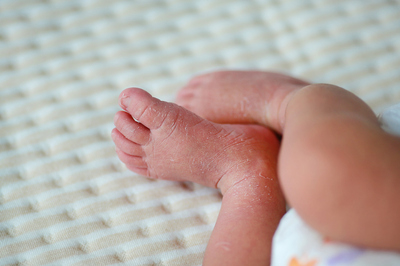Baby Skin Conditions: Diaper Rash, Baby Eczema and More

We hate to see our babies in any sort of pain. Diaper rash, eczema and other such skin issues however, can certainly cause little ones great discomfort. From red itchy patches, to dry scaly bumps, it is important to understand the different types of potential pediatric skin conditions that could be afflicting your infant.
Generally, not considered medical emergencies, rashes especially on what should be otherwise smooth and soft baby skin are still of concern to parents who can’t stand to watch their child deal with the symptoms. The good news is that by learning how to recognize the signs and being able to distinguish between diaper rashes, heat rashes, and/or eczema, you are better positioned to soothe your baby’s skin and help them get the relief that they need.
Baby Eczema
Also known as atopic dermatitis, eczema is more common in children and particularly infants than many realize. Roughly 20% of young children develop this condition and it is characterized by patches of dry, scaly skin that appears thicker than unaffected skin tissue. The impulse to scratch can make the situation worse and even cause scarring. While this skin condition cannot be cured, the flareups may be controlled by taking certain steps as far as caring for your baby.
Areas Effected
- Face
- Scalp
- Arms
- Legs
- Chest
Treatment
What can you do at home to help manage an eczema outbreak and thus bring relief to your child? Keep in mind, that your infant’s skin, as it is now prone to flareups, is probably a bit more sensitive to external factors. For instance, certain fabrics such as wool and synthetic fibers could easily irritate a baby’s skin and trigger the eczema (cotton and fine linens are safer alternatives). Also, you want to be sure and use only fragrance-free soaps and detergents when it comes to your child’s things, as well as for bath time. Be sure that following a bath, you gently pat your child’s skin dry rather than rubbing, as this again, can irritate the skin. Directly after a bath, while the skin is still moist, is the best time to moisturize your child’s skin to lock in that moisture.
Additionally, as eczema is marked by very dry skin, you want to try and keep the house on the more humid side, also vacuuming perhaps more frequently than you normally would is good practice as this minimizes dust in the air. With children who do suffer from eczema, often having a pet and the corresponding pet dander that they bring can also lead to outbreaks.
Depending on the frequency of your baby’s eczema flare-ups, you may want to start keeping a notepad or journal handy so that you can write down any triggers that seem to irritate your infant’s skin. This way too, when talking to a pediatric dermatologist, you will have a detailed record of your child’s condition. This in turn will help them as they determine the best course of treatment for the child.
Some dermatologists may prescribe steroid cream generally applied once or twice a day given the severity and number of flareups your baby experiences. When used under a physician’s directive and following instructions carefully, the cream can help soothe your baby and clear up the afflicted areas. The dermatologist will also review with you an approach to dealing with childhood eczema over the long term. From what types of soaps you use, to sleeping patterns, to helping prevent excessive scratching, your doctor is a great source for information regarding eczema care. Learn more about treatment for eczema.
Diaper Rash
Every parent at one point or another will most likely have to contend with diaper rash when it comes to their infant. Most often affecting those under one year of age, diaper rash is quite common and is usually the result of skin becoming irritated by moisture and friction caused by diapers. The skin will become red and thus uncomfortable for the baby. If left untreated, diaper rash can become infected by bacteria or fungus, so it is important to tend to the affected area as soon as you notice it.
Areas Effected
- Bottom
Treatment
In treating the symptoms of diaper rash there are topical creams available that can help ease the discomfort, such as petroleum jelly or those that contains zinc oxide. Also, keep in mind especially as the child is healing from a rash you may want to remove the diaper periodically and thereby allow the skin to air out.
Heat Rash
True to its name, heat rash is most often caused when a child gets sweaty and hot. Basically, what happens is that as the child gets hot, they sweat; however, because babies have very tiny pores, those sweat glands can become clogged which in turn hastens a rash. While such a skin condition is seen most often during the hotter months, over-layering a baby in the winter can also have the same effect.
Areas Effected
- Neck
- Face
- Back
- Bottom
Treatment
Fortunately, this is very easy to treat. The key is to cool your child down. If their clothes are heavy and damp, change them into lighter, dry clothing. Avoid occlusive ointments (such as Vaseline) on the skin which do not allow the skin to breath. You may even try lowering the temperature inside the house. Heat rash may resolve within days but if it lasts beyond that it is best to see a medical provider.
Cradle Cap
So what exactly is cradle cap? Also known as seborrheic dermatitis, this is a form of baby dandruff. However, unlike with adults where the skin lightly flakes, in babies this can also be accompanied by thick and crusty skin apparent throughout their scalp. This is a common pediatric skin condition and most often is not harmful.
Areas Effected
- Scalp
Treatment
While certainly for greater peace of mind you might talk to your dermatologist regarding things that you can do to alleviate cradle cap, treating your child at home is fairly easy to do. One thing you might try is hydrating the scalp; this can be done using baby oil, mineral oil or even a little petroleum jelly. You can also very gently brush the baby’s scalp with a special brush designed specifically for cradle cap.
We completely understand that the look and feel of some rashes which may appear on your baby can be alarming to parents. Fortunately, many skin conditions are simply a part of infancy and can be easily dealt with. If you are particularly concerned or even just have questions, it’s never a bad idea to consult with a board certified pediatric dermatologist. Keeping your baby happy and healthy is most definitely a priority!
